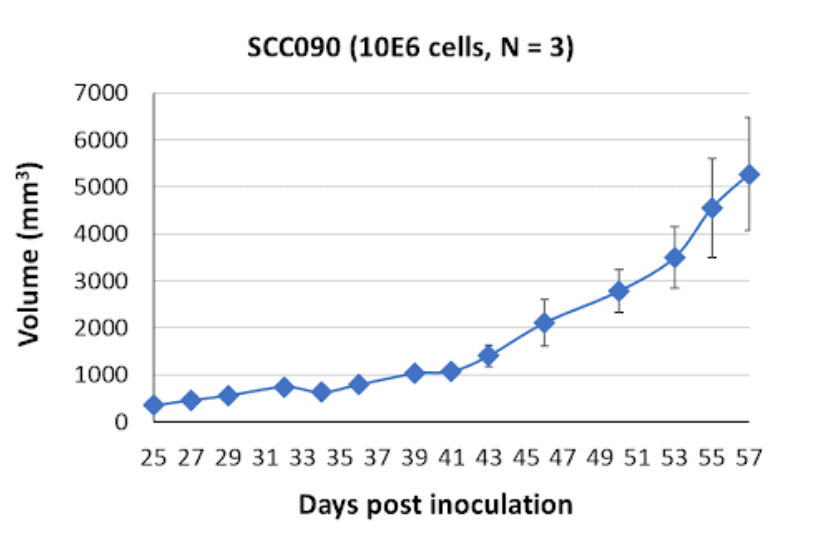About UPCISCC090
The UPCISCC090 cell line derived from a 46-year-old white male patient with neck squamous cell carcinoma, offers a unique model to investigate the molecular mechanisms underlying development and progression head and neck cancer. Isolated in 1994, the UPCISCC090 cell line has been extensively utilized as a preclinical model to unravel the genetic and molecular alterations associated with tumorigenesis.
This cell line is characterized by specific mutations in the CDKN2A and NOTCH1 genes, which play critical roles in cell cycle regulation and cellular signaling pathways. Importantly, the TP53 gene in the UPCISCC090 cell line remains in its wildtype form, presenting an ideal scenario for studying the interplay between tumorigenic mutations and the TP53 pathway.
A novel area of interest revolves around the role of microRNAs (miRNAs) in the pathogenesis of head and neck cancer. miRNAs are small non-coding RNA molecules that regulate gene expression and have been implicated in various cellular processes, including tumorigenesis. By utilizing the UPCISCC090 cell line, researchers can explore the dysregulation of specific miRNAs and their impact on critical signaling pathways involved in cancer initiation, progression, and therapeutic response. Understanding the role of miRNAs in the UPCISCC090 cell line can provide valuable insights into potential diagnostic and therapeutic targets for head and neck cancer patients.
Another feature of the UPCISCC090 cell line is the presence of a subpopulation of cancerous stem-like cells. These cells possess self-renewal capabilities and have been implicated in tumor initiation, progression, and drug resistance. Investigating the molecular characteristics and signaling pathways associated with these stem-like cells in the can shed light on the mechanisms underlying their functional properties and their contribution to tumor heterogeneity and therapeutic resistance. These studies hold promise for the development of targeted therapies aimed at eradicating this highly resilient cell population.
UPCISCC090 Tumor Kinetics in the SRG™ Rat

Notably, the UPCISCC090 cell line exhibits Human Papilloma Virus (HPV) positivity, particularly HPV-16. This characteristic makes the cell line an excellent model for studying the HPV-16 disease process and its impact on head and neck cancer development. Researchers can utilize the UPCISCC090 cell line to investigate the interplay between HPV infection and cellular signaling pathways, deciphering the mechanisms by which HPV contributes to tumor initiation, progression, and response to therapy. Moreover, this cell line serves as a valuable assay for evaluating potential therapeutic agents targeting HPV-related head and neck cancers.
Products & Services
Xenograft Efficacy Studies
Includes collection of blood, tissues & tumor for ADME, PK/PD and analysis.
(Bi)weekly Tumor Sampling
Via fine needle aspiration (FNA). For longitudinal evaluation of drug exposure, histology and gene expression.
OncoRats
Cutting edge models optimized for engraftment.
Get help with your research by scheduling a call with Hera.
References (MLA):
- Kabzinski , Jacek, et al. “MicroRNA as a Novel Biomarker in the Diagnosis of Head and Neck Cancer.” PubMed, June 2021, pubmed.ncbi.nlm.nih.gov/34198889/.
- Kalu, Nene N., et al. “Genomic Characterization of Human Papillomavirus-Positive and -Negative Human Squamous Cell Cancer Cell Lines.” Oncotarget, 21 Sept. 2017, www.oncotarget.com/article/21174/text/.
- Kilmister, Ethan J., et al. “Cancer Stem Cell Subpopulations Are Present within Metastatic Head and Neck Cutaneous Squamous Cell Carcinoma.” Frontiers, 1 June 2020, www.frontiersin.org/articles/10.3389/fonc.2020.01091/full.
- Liu, Mengfei, et al. “Absence of NOTCH1 Mutation and Presence of CDKN2A Deletion Predict Progression of Esophageal Lesions.” Pathological Society Journal, 25 May 2022, pathsocjournals.onlinelibrary.wiley.com/doi/10.1002/path.5970.
